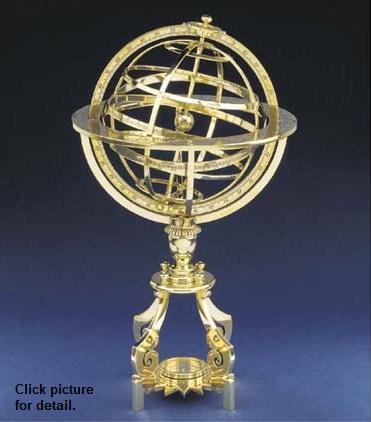
 A
reproduction of a
rare mid - 18th
Century
brass Ptolemaic armillary sphere, after Daniel Heckinger III, Augsburg
(1735). The foot is composed of four scrolled brackets that
straddle a windrose below and support a disc above. The wind rose is
cut with sixteen triangular points each labelled with the appropriate
wind: e.g., NORD, OST, SUD, WEST. At the centre is a pin-bearing with a
magnetic compass with cover and needle. The edge is divided into
degrees 0 - 90 in four quadrants, and the magnetic declination is
marked by an arrow at 18º West of North because this is the value
applied between 1730 and 1750 in Augsburg (Wagner, 1997).
A
reproduction of a
rare mid - 18th
Century
brass Ptolemaic armillary sphere, after Daniel Heckinger III, Augsburg
(1735). The foot is composed of four scrolled brackets that
straddle a windrose below and support a disc above. The wind rose is
cut with sixteen triangular points each labelled with the appropriate
wind: e.g., NORD, OST, SUD, WEST. At the centre is a pin-bearing with a
magnetic compass with cover and needle. The edge is divided into
degrees 0 - 90 in four quadrants, and the magnetic declination is
marked by an arrow at 18º West of North because this is the value
applied between 1730 and 1750 in Augsburg (Wagner, 1997).
From the disc rises a baluster stem with a fluted cap, holding two
crossed semicircles that support the armillary sphere. The horizon ring
is divided into the calendar and zodiac. Each division of the zodiac
has the name and symbol representation.
The Armillary Sphere is made from strips of brass, with a meridian ring
which is divided on one side into degrees, with half of the ring
labelled from 90-0-90, the other from 0-90-0. At the top is a 24-hour
circle with a pointer. The rings are labelled and the ecliptic band is
divided in divisions of the zodiac, with names and symbols. A small
Earth ball 9/16 in diameter (23mm) has an equatorial band, and an
ecliptic band and turns on a central rod.
The overall height is 16 ¾ in ( 425mm); radius of horizontal
ring 9 7/8 in (250mm) Signed Dean R. White fecit Bampton Devonia (and dated)
Wagner, Gerhard G. Sonnenuhren und wissenschaftliche Instrumente (Wurzburg: Mainfrankisches Museum, 1997) p.55.